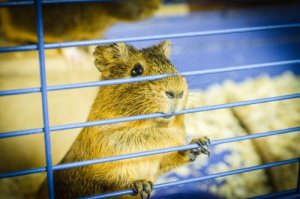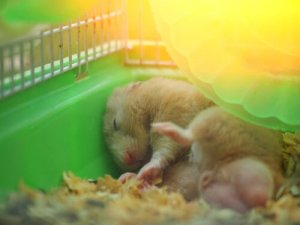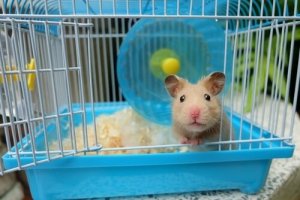How to Create the Perfect Home for Your Small Animals

Creating the perfect home for small animals such as hamsters may seem complicated. But with a little patience and creativity, you’ll be able to give your pet the ideal place to live and have fun.
Studies have shown that hamsters and other rodents enjoy having a comfortable and welcoming environment. Investigators at Liverpool John Moore’s University in England studied 30 hamsters to determine whether enriching their environment with toys and more comfortable bedding would affect the decisions they took when faced with uncertain situations.
What they found was that hamsters with additional toys and extra bedding were more likely to make optimistic decisions than those with fewer luxuries. For example, one experiment showed that they were more likely to try out different water bottles to find out which water tasted best. Less optimistic hamsters were more reluctant to try out new things.
Scientists use optimistic judgment as an indicator of well-being in humans, so using the same method to measure the well-being of hamsters makes a lot of sense. Giving your pets a nice comfortable environment is therefore an important part of their everyday care. So, in this article, we’ll give you 7 top tips for creating the perfect home for any small animal.
1. Small animals need plenty of space
Rodents are extremely active at night, and need plenty of space to explore, play, climb, and exercise. Give them as big a cage as you can. The top half should be made of metal bars, while the bottom should be solid plastic (ideally at least 2 inches deep).

Make sure that the bars are narrow enough, especially if you have something small, like a dwarf hamster. These miniature escape artists are so intelligent that they can easily break out if given the chance.
2. Multilevel cages
Multilevel cages have lots of different platforms, making the most of all the available space, and giving your pet more room to explore. The bars allow them to climb around the sides of the cage, serving as both a source of entertainment and exercise.
3. Peace and quiet
Rodents are very sensitive to high-frequency noises that we humans can’t even hear. Place your pet’s cage far from any objects that can produce ultrasonic noise, such as TV’s, computers, vacuum cleaners or running water.

4. Cage and bedding materials
In the wild, rodents are excellent diggers, making themselves deep, dark underground burrows. Your pets will love having a deep layer of bedding where they can dig to their heart’s content. Make sure you give them enough material to make themselves the perfect nest.
5. Small animals – beds
Your pet will need a nest or hidey-hole it can retreat to during the day, somewhere it feels safe and can sleep soundly. The shelter needs to be big enough for them to store food, make a nest, and move around comfortably.

When it comes to small animal beds, there are many options to choose from, from wooden arches and cabins to plastic beds. You can also recycle everyday cardboard items, such as empty Kleenex boxes. Your pet will have great fun chewing it to pieces!
6. En suite bathrooms
Rodents such as chinchillas need to take sand baths to help keep their fur clean. A ceramic dish filled with sand will make the perfect bathtub (although they may also use it as a litter tray).
7. Toys for small animals
When it comes to toys, accessories, and finding fun things to chew, rodents can never get enough. You can find all kinds of things in pet stores, including tunnels, climbing blocks, ladders, bridges, wooden chew blocks, and all sorts of different treats.

You can even make the toys yourself. Cardboard toilet roll tubes make great tunnels, and cardboard boxes are perfect for climbing and nesting. Why not go all out and make them a huge cardboard box castle? This will give them hours of fun.
A nice environment = a happy pet
If you want to know how your pet is feeling, take a look at its body language:
- Yawning is a sign that your pet is pleasantly sleepy and comfortable.
- If it makes itself a deep nest, stores food, or does crazy acrobatics around the cage, your rodent is happy.
- Sniffing the air is a sign that your pet has discovered something new.
- If your pet seems relaxed, it’s because its environment is peaceful and comfortable.
- Leaping in the air and playing are signs that your pet is in a great mood.
- Stretching is a sign that they are relaxed and comfortable.
Creating the perfect home for small animals such as hamsters may seem complicated. But with a little patience and creativity, you’ll be able to give your pet the ideal place to live and have fun.
Studies have shown that hamsters and other rodents enjoy having a comfortable and welcoming environment. Investigators at Liverpool John Moore’s University in England studied 30 hamsters to determine whether enriching their environment with toys and more comfortable bedding would affect the decisions they took when faced with uncertain situations.
What they found was that hamsters with additional toys and extra bedding were more likely to make optimistic decisions than those with fewer luxuries. For example, one experiment showed that they were more likely to try out different water bottles to find out which water tasted best. Less optimistic hamsters were more reluctant to try out new things.
Scientists use optimistic judgment as an indicator of well-being in humans, so using the same method to measure the well-being of hamsters makes a lot of sense. Giving your pets a nice comfortable environment is therefore an important part of their everyday care. So, in this article, we’ll give you 7 top tips for creating the perfect home for any small animal.
1. Small animals need plenty of space
Rodents are extremely active at night, and need plenty of space to explore, play, climb, and exercise. Give them as big a cage as you can. The top half should be made of metal bars, while the bottom should be solid plastic (ideally at least 2 inches deep).

Make sure that the bars are narrow enough, especially if you have something small, like a dwarf hamster. These miniature escape artists are so intelligent that they can easily break out if given the chance.
2. Multilevel cages
Multilevel cages have lots of different platforms, making the most of all the available space, and giving your pet more room to explore. The bars allow them to climb around the sides of the cage, serving as both a source of entertainment and exercise.
3. Peace and quiet
Rodents are very sensitive to high-frequency noises that we humans can’t even hear. Place your pet’s cage far from any objects that can produce ultrasonic noise, such as TV’s, computers, vacuum cleaners or running water.

4. Cage and bedding materials
In the wild, rodents are excellent diggers, making themselves deep, dark underground burrows. Your pets will love having a deep layer of bedding where they can dig to their heart’s content. Make sure you give them enough material to make themselves the perfect nest.
5. Small animals – beds
Your pet will need a nest or hidey-hole it can retreat to during the day, somewhere it feels safe and can sleep soundly. The shelter needs to be big enough for them to store food, make a nest, and move around comfortably.

When it comes to small animal beds, there are many options to choose from, from wooden arches and cabins to plastic beds. You can also recycle everyday cardboard items, such as empty Kleenex boxes. Your pet will have great fun chewing it to pieces!
6. En suite bathrooms
Rodents such as chinchillas need to take sand baths to help keep their fur clean. A ceramic dish filled with sand will make the perfect bathtub (although they may also use it as a litter tray).
7. Toys for small animals
When it comes to toys, accessories, and finding fun things to chew, rodents can never get enough. You can find all kinds of things in pet stores, including tunnels, climbing blocks, ladders, bridges, wooden chew blocks, and all sorts of different treats.

You can even make the toys yourself. Cardboard toilet roll tubes make great tunnels, and cardboard boxes are perfect for climbing and nesting. Why not go all out and make them a huge cardboard box castle? This will give them hours of fun.
A nice environment = a happy pet
If you want to know how your pet is feeling, take a look at its body language:
- Yawning is a sign that your pet is pleasantly sleepy and comfortable.
- If it makes itself a deep nest, stores food, or does crazy acrobatics around the cage, your rodent is happy.
- Sniffing the air is a sign that your pet has discovered something new.
- If your pet seems relaxed, it’s because its environment is peaceful and comfortable.
- Leaping in the air and playing are signs that your pet is in a great mood.
- Stretching is a sign that they are relaxed and comfortable.
All cited sources were thoroughly reviewed by our team to ensure their quality, reliability, currency, and validity. The bibliography of this article was considered reliable and of academic or scientific accuracy.
http://hamsterhideout.com/forum/topic/93786-natural-hamster-cage-ideas/
https://healthypets.mercola.com/sites/healthypets/archive/2015/11/12/how-to-make-hamsters-happier.aspx
This text is provided for informational purposes only and does not replace consultation with a professional. If in doubt, consult your specialist.








